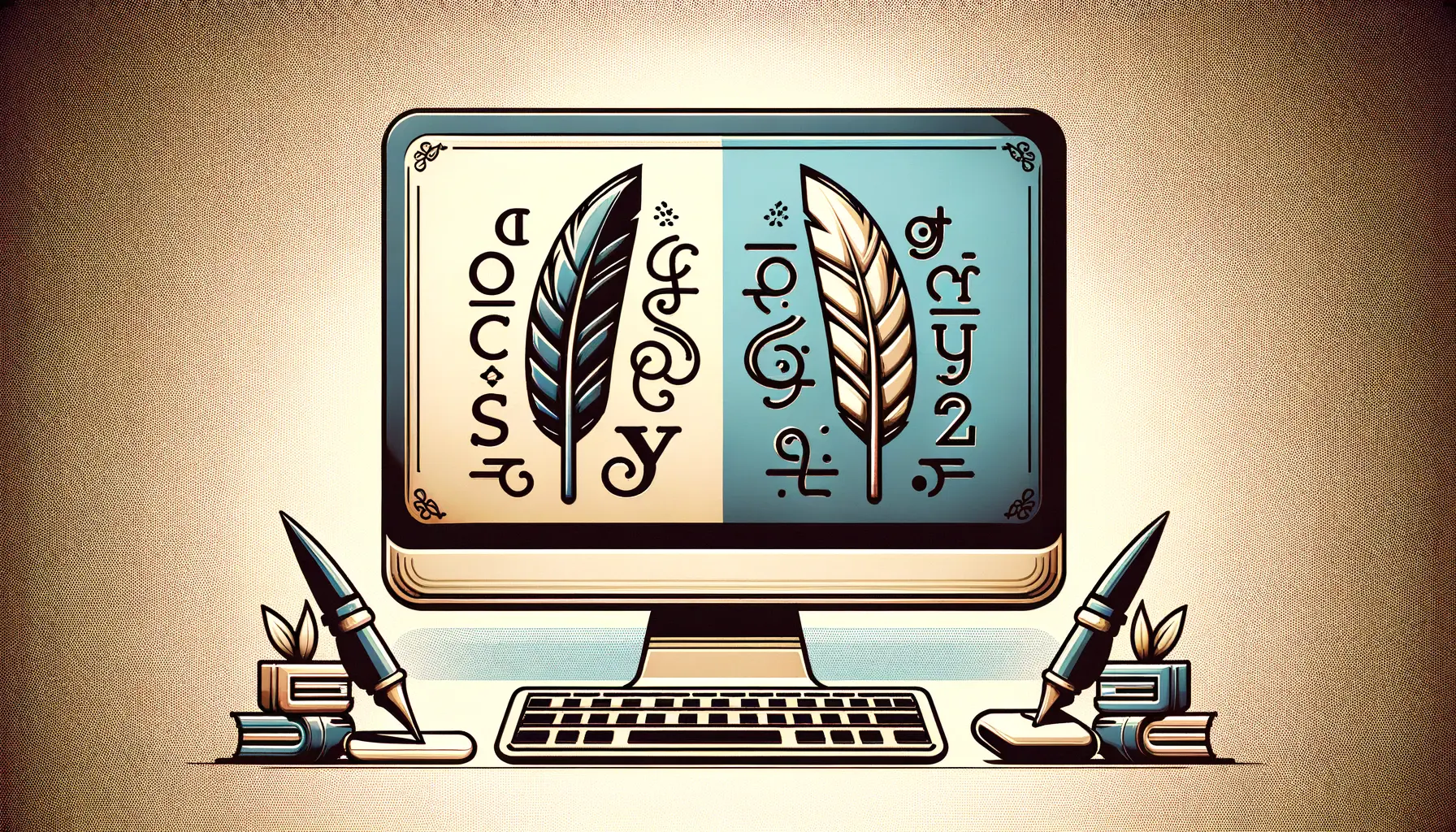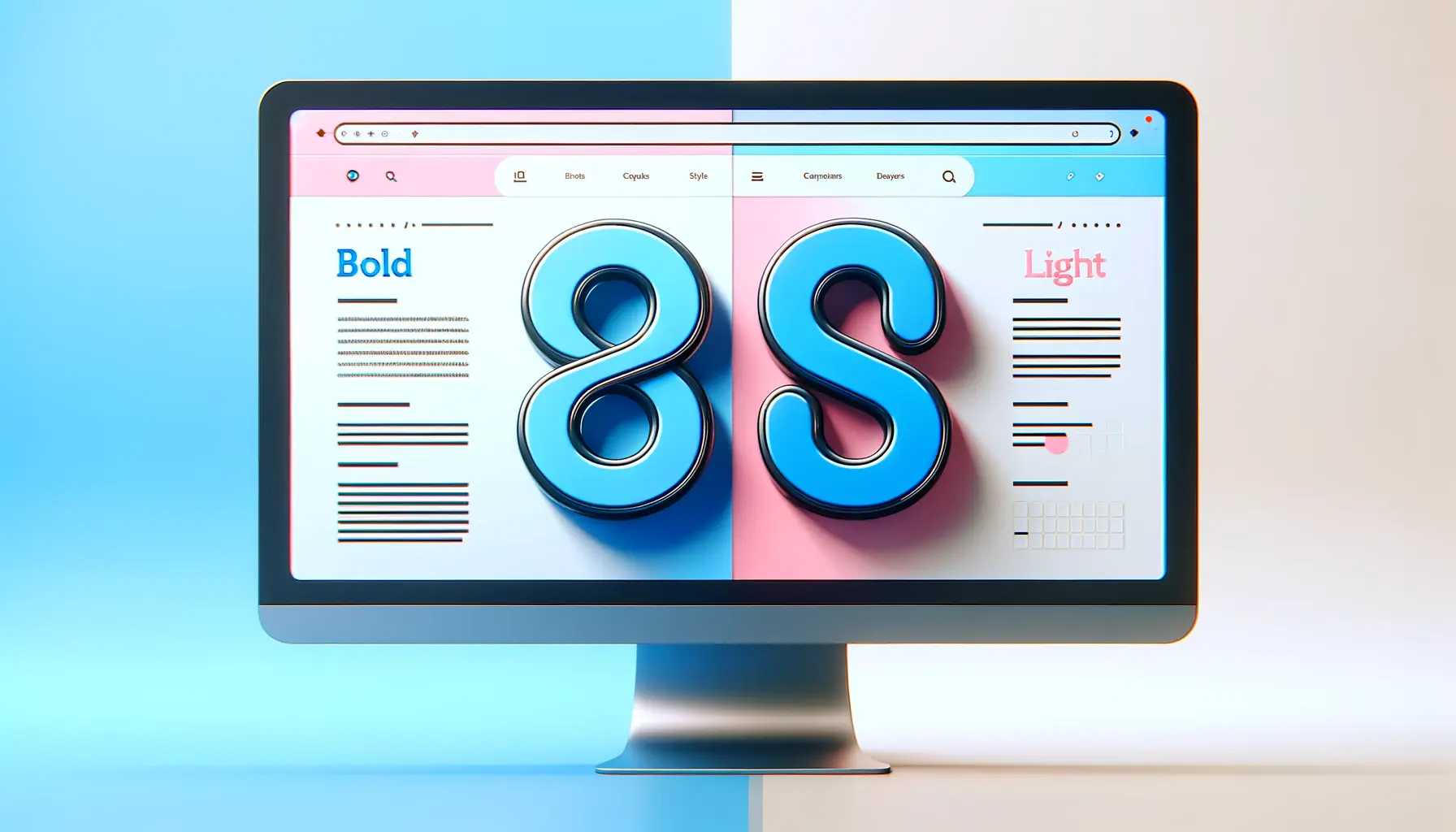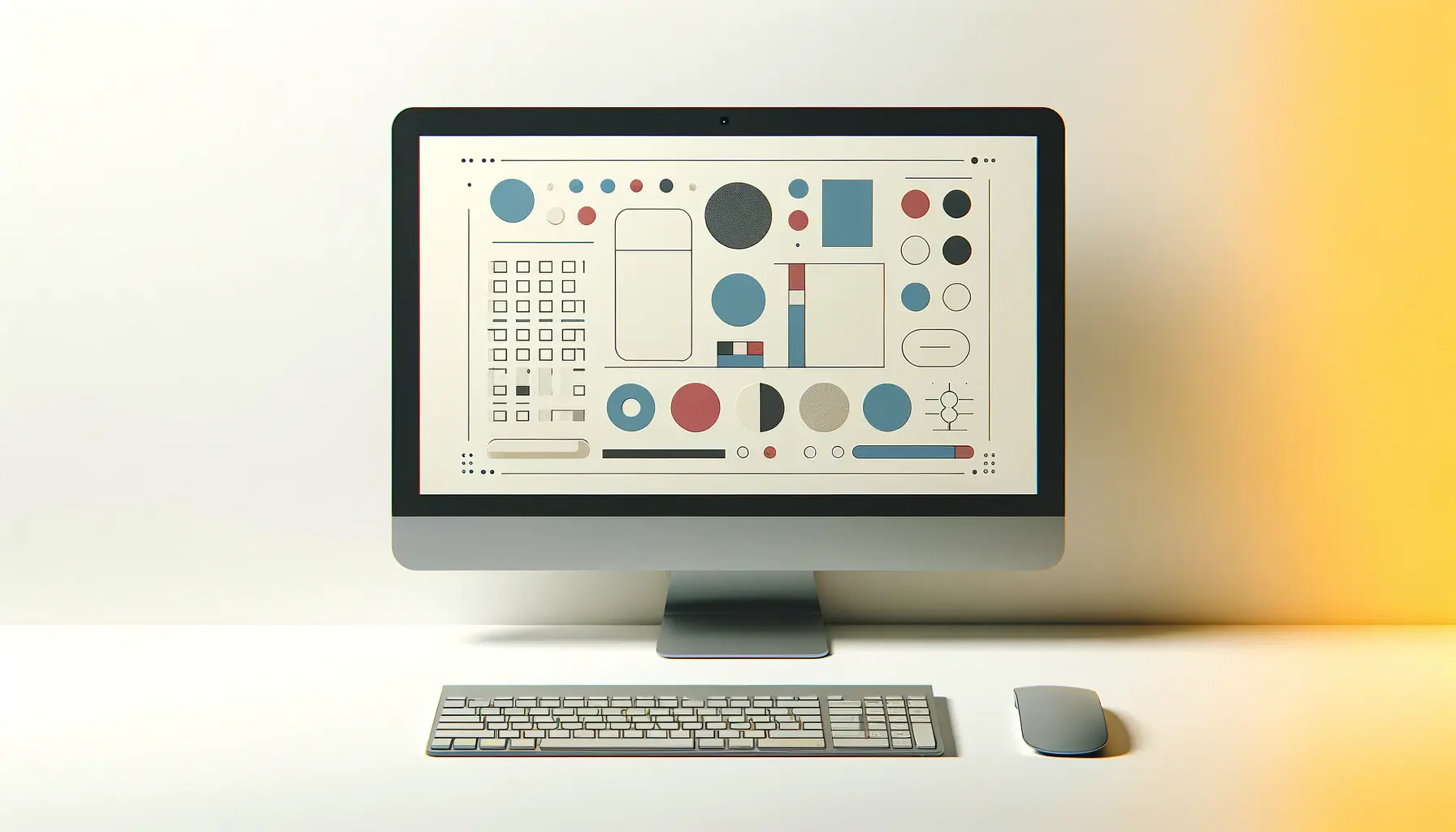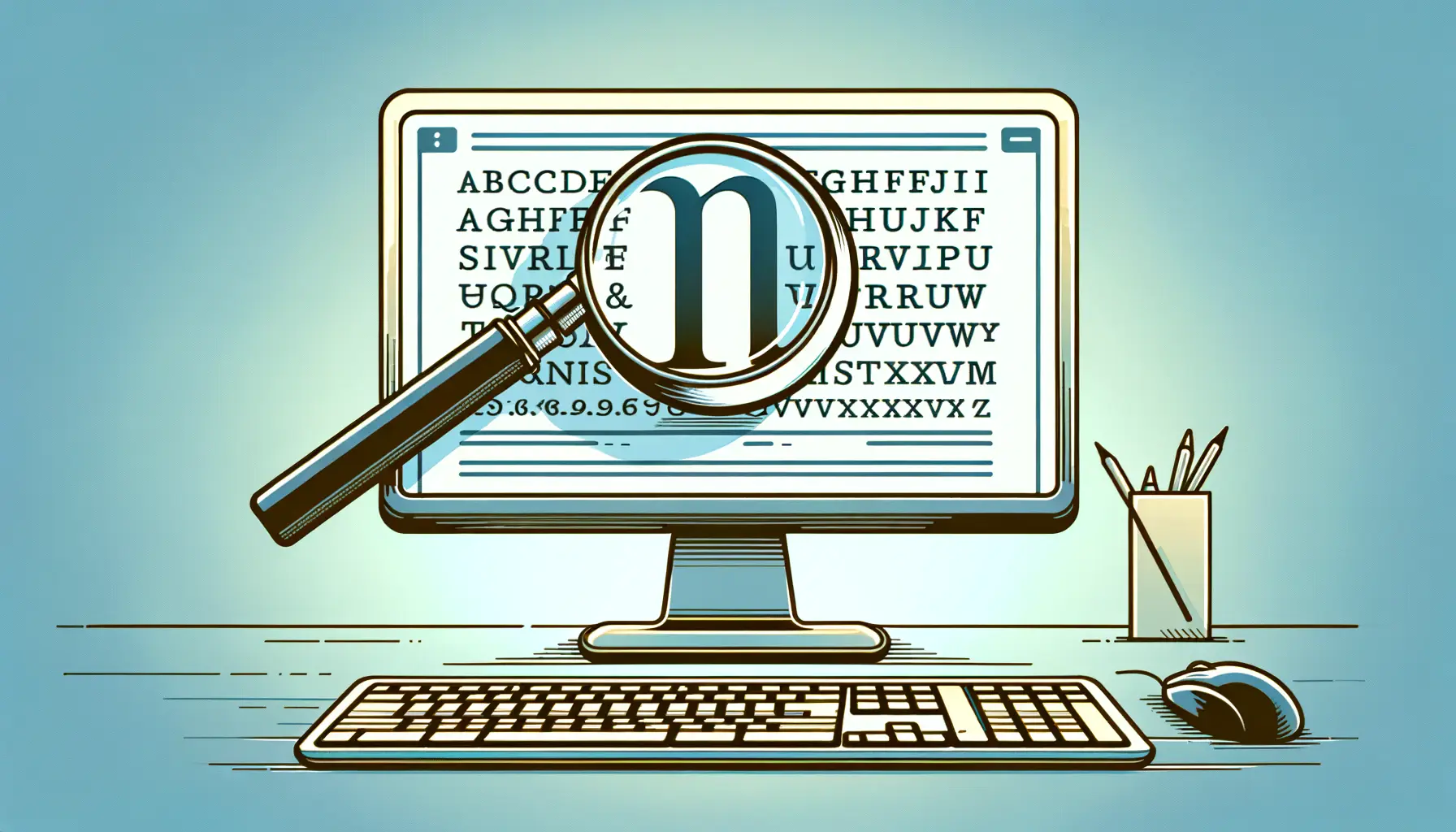The interplay between serif and sans-serif fonts is a foundational aspect of typography that can significantly impact the aesthetic and functionality of a design.
This dynamic duo, when used effectively, can create a visual hierarchy, guide the reader’s eye, and establish an engaging rhythm in the text.
The choice between serif and sans-serif fonts is not merely a matter of preference but a strategic design decision that can enhance readability, convey specific moods, and reinforce the message of the content.
Understanding the characteristics and historical contexts of serif and sans-serif fonts is crucial for designers.
Serif fonts, known for their decorative strokes or feet at the ends of letters, have been traditionally associated with print and long-form text due to their readability.
On the other hand, sans-serif fonts, characterized by their clean and straightforward lines without additional flourishes, are often used for digital screens and modern designs.
The contrast between these two font families can be harnessed to create compelling and harmonious designs that captivate and inform.
- The Role of Typography in Design
- Historical Context and Evolution
- Choosing the Right Font Pairings
- Typography in Web Design
- Typography Trends in Digital Media
- Accessibility and Typography
- Typography’s Influence on User Experience
- Embracing the Power of Typography: A Conclusion
- FAQs on Creating Contrast with Serif and Sans-serif Fonts
The Role of Typography in Design
Understanding Typography’s Impact
Typography is not just about choosing attractive fonts; it’s about employing type to communicate effectively.
The right typography can elevate a design, evoke emotions, and ensure the message is delivered with clarity.
In the realm of design, typography is a tool that can be wielded to guide the reader’s attention, establish the tone of the content, and make the difference between a forgettable design and one that stands out.
Moreover, typography plays a crucial role in brand identity.
It can make a brand appear more professional, friendly, or avant-garde, depending on the chosen fonts.
The interplay between different font styles, such as serif and sans-serif, allows designers to create a visual language that supports the brand’s personality and values.
Contrast and Readability
Contrast is a fundamental principle in design, and typography offers a myriad of ways to achieve it.
Pairing serif and sans-serif fonts is a classic technique to create contrast within textual content.
This contrast not only adds visual interest but also improves readability by clearly distinguishing between headings, subheadings, and body text.
By carefully selecting fonts that complement yet contrast with each other, designers can create a structured and engaging layout that enhances the reader’s experience.
Readability is paramount in any design project.
The primary goal of typography is to ensure that text is not only legible but also easy to read and understand.
The choice between serif and sans-serif fonts can affect readability, especially in different mediums.
For instance, serif fonts are often favored in printed materials for their readability, while sans-serif fonts are preferred on digital screens for their clean appearance.
The strategic use of serif and sans-serif fonts can significantly enhance the effectiveness of a design by creating contrast, establishing hierarchy, and improving readability.
Historical Context and Evolution
The history of serif and sans-serif fonts is rich and varied, reflecting the evolution of writing and printing technologies over centuries.
Understanding this historical context can provide valuable insights into why these fonts have developed their distinct characteristics and how they’ve come to be used in modern design.
Serif fonts, with their origins tracing back to Roman inscriptions, were designed to guide the flow of the brush.
The serifs at the end of each stroke helped to define the structure of letters in stone carvings, making them easier to read from a distance.
This practical feature translated well into the world of print, where serif fonts dominated for centuries due to their readability and elegance.
- The Rise of Sans-serif: Sans-serif fonts emerged in the 18th century but didn’t gain widespread popularity until the 19th and 20th centuries. The Industrial Revolution and modernist movements in art and design called for a cleaner, more straightforward approach to typography, leading to the increased use of sans-serif fonts in both commercial and artistic contexts.
- Technological Advancements: The development of digital screens and interfaces in the late 20th century further propelled the popularity of sans-serif fonts. Their simple, clean lines render more clearly on low-resolution screens, making them a practical choice for digital design.
Impact on Modern Design
The historical evolution of serif and sans-serif fonts has had a profound impact on their application in modern design.
Designers often draw on the traditional associations of serif fonts with credibility and authority for projects that require a formal tone.
In contrast, sans-serif fonts are favored for their modern and approachable feel, making them ideal for contemporary brands and digital platforms.
- Print vs. Digital: The medium of the design project often influences the choice between serif and sans-serif. Print materials, such as books and newspapers, frequently utilize serif fonts for body text due to their legibility. Meanwhile, digital designs, including websites and mobile apps, lean towards sans-serif fonts for their clarity on screens.
- Brand Identity: The choice between serif and sans-serif fonts can also reflect a brand’s identity and values. A luxury brand might opt for elegant serif fonts to convey sophistication, while a tech startup might choose clean sans-serif fonts to emphasize innovation and accessibility.
The historical context of serif and sans-serif fonts enriches our understanding of their characteristics and informs their strategic use in modern design to achieve specific aesthetic and communicative goals.
Choosing the Right Font Pairings
The art of pairing serif and sans-serif fonts is akin to finding the perfect ingredients for a gourmet dish.
The combination needs to be balanced, with each font playing its role without overshadowing the other.
The key to successful font pairing lies in understanding the unique qualities of each font and how they can complement each other to enhance the design’s overall impact.
When selecting serif and sans-serif fonts to pair together, designers must consider several factors, including the project’s tone, the fonts’ weights, and the intended message.
A well-chosen font pairing can elevate a design from good to great, creating a visually appealing and coherent piece that effectively communicates its intended message.
- Contrast and Harmony: Look for fonts that offer a good balance of contrast and harmony. The serif font should provide a counterpoint to the sans-serif without clashing. This can be achieved by matching fonts with similar x-heights or selecting fonts from the same design era.
- Functionality: Consider the readability and functionality of the fonts in various contexts. For example, a delicate serif might not be suitable for body text in a digital interface, while a robust sans-serif could be perfect for headings.
- Mood and Tone: The fonts should match the mood and tone of the design. A playful sans-serif paired with a serious serif might send mixed signals, unless that’s the intended effect.
Examples of Effective Font Pairings
Exploring successful font pairings can inspire designers and help them understand what makes a combination work.
Here are a few examples of serif and sans-serif pairings that demonstrate balance, contrast, and harmony:
- Garamond and Helvetica: Garamond’s timeless elegance paired with Helvetica’s clean simplicity creates a classic and professional look suitable for editorial and corporate designs.
- Playfair Display and Futura: The dramatic flair of Playfair Display contrasts beautifully with the geometric precision of Futura, ideal for fashion and lifestyle brands.
- Merriweather and Open Sans: The readability of Merriweather makes it a great choice for body text, while Open Sans provides clear and friendly headings, perfect for blogs and educational websites.
Remember, the best font pairings are those that achieve the right balance between contrast and harmony, enhancing the design’s message and aesthetic appeal.
Typography in Web Design
Typography in web design is not just about making words look attractive; it’s about usability and ensuring that information is easily accessible to everyone.
The choice between serif and sans-serif fonts plays a crucial role in the readability and overall user experience of a website.
With the vast majority of interactions happening on screens of various sizes, selecting the right fonts becomes a critical design decision.
Web typography involves more than just font choice; it encompasses the arrangement and appearance of text across different devices and platforms.
It’s about creating a hierarchy that guides users through the content, making the website not only beautiful but also functional and user-friendly.
- Screen Readability: Sans-serif fonts are generally preferred for body text on websites due to their clarity and legibility on screens. Their simple, clean lines render well even at smaller sizes or on low-resolution displays.
- Responsive Design: A responsive design adapts to the size and orientation of the user’s screen. Typography must be flexible, with font sizes and line spacing adjusting to improve readability on mobile devices and desktops alike.
- Loading Times: Web fonts can affect a site’s loading times. It’s important to balance aesthetic choices with performance, ensuring that the use of web fonts does not significantly impact the site’s speed.
Implementing Typography Best Practices
Effective typography in web design is achieved by adhering to best practices that enhance readability and user experience.
Here are some key considerations for implementing typography on the web:
- Hierarchy and Scale: Establish a clear hierarchy using different font sizes, weights, and styles. Headings, subheadings, and body text should be easily distinguishable to help users navigate the content.
- Line Length and Spacing: Optimal line length and spacing improve readability. Lines should not be too long or too short, and adequate spacing helps prevent text from appearing cramped.
- Color and Contrast: Text color should contrast well with the background to ensure legibility. High contrast between text and background is especially important for users with visual impairments.
A well-designed typography system is essential for creating an effective and accessible web design that provides a positive user experience across all devices.
Typography Trends in Digital Media
The digital landscape is constantly evolving, and with it, the trends in typography that captivate audiences and push the boundaries of design.
Keeping abreast of these trends is crucial for designers looking to create fresh and relevant digital experiences.
From bold statement fonts to dynamic variable fonts, the trends in digital typography are shaping how content is consumed online.
As technology advances, so does the capability to experiment with typography in digital media.
High-resolution displays and improved web standards have opened up a world of possibilities for using diverse and dynamic fonts that were once restricted by technical limitations.
- Dynamic and Variable Fonts: Variable fonts allow designers to adjust a font’s weight, width, and other attributes on the fly, creating custom styles for different screen sizes and orientations without loading multiple font files.
- Color Fonts and Gradients: The use of color fonts and gradients in typography adds depth and vibrancy to digital designs, making text an integral part of the visual experience.
- Custom and Hand-drawn Fonts: Custom fonts tailored to a brand’s identity and hand-drawn fonts offer uniqueness and personality, setting digital platforms apart from the competition.
Incorporating Trends with Timelessness
While it’s exciting to experiment with emerging typography trends, it’s also important to balance novelty with timelessness.
The goal is to create digital experiences that are not only visually striking but also enduring and accessible.
Here’s how designers can incorporate trends thoughtfully:
- Select Fonts with Purpose: Choose fonts that align with the brand’s identity and the message of the content. A trendy font might catch the eye, but it should also support the overall design narrative.
- Focus on Readability: Regardless of how trendy a font is, readability should never be compromised. The primary function of text is to communicate, and fonts should facilitate that communication clearly and effectively.
- Mix Trends with Classic Elements: Pairing a trendy font with a classic serif or sans-serif can create a balanced design that is both modern and grounded.
Embracing typography trends in digital media allows designers to create engaging and innovative designs, but the best designs are those that achieve a harmonious balance between trendiness and timelessness.
Accessibility and Typography
Accessibility in design ensures that digital content is usable by as wide an audience as possible, including those with disabilities.
Typography plays a crucial role in accessibility, as the choice of fonts, sizes, colors, and spacing can significantly impact the readability and usability of digital content for users with visual impairments, dyslexia, or other challenges.
Designers have a responsibility to consider these factors in their work to create inclusive digital experiences.
By adhering to accessibility guidelines and best practices in typography, designers can ensure that their content is not only beautiful but also accessible to everyone.
- Legible Font Choices: Choose fonts that are easy to read and distinguish from one another. Avoid fonts with overly decorative or complex characters that might confuse readers or make text hard to decipher.
- Adequate Contrast: Ensure high contrast between text and its background to improve legibility. Text should stand out clearly against the background, making it easier for users with visual impairments to read.
- Scalable Text: Design text to be scalable, allowing users to adjust font sizes without losing the integrity of the design. This is particularly important for users with low vision who may need larger text to read comfortably.
Implementing Accessible Typography
Implementing accessible typography requires a thoughtful approach that considers the diverse needs of users.
Here are some strategies designers can use to enhance accessibility:
- Use Semantic HTML for Structure: Use HTML tags correctly to structure content, making it easier for screen readers to interpret and navigate. Headings, paragraphs, and lists should be marked up semantically.
- Responsive and Flexible Layouts: Design layouts that are responsive and flexible, ensuring that typography adjusts gracefully across devices and screen sizes. This helps maintain readability and usability in various contexts.
- Testing with Users: Test designs with real users, including those with disabilities, to identify and address any accessibility issues. User feedback is invaluable in creating designs that are truly accessible.
By prioritizing accessibility in typography, designers can create digital content that is not only inclusive but also more usable and enjoyable for all users, regardless of their abilities or circumstances.
Typography’s Influence on User Experience
Typography extends beyond the mere selection of fonts; it is a powerful tool that significantly influences user experience (UX) in digital media.
The way text is presented can affect how users perceive content, navigate websites, and interact with digital products.
Effective typography guides users through the digital landscape, making their journey intuitive and enjoyable.
Good typography enhances the usability of digital products by organizing content into digestible sections, making information easy to find and understand.
It contributes to a site’s visual hierarchy, directing attention to important elements and ensuring a seamless flow of information.
- Creating Emotional Connections: Typography can evoke emotions and set the tone for user interactions. The choice of fonts can make a digital environment feel welcoming, professional, or dynamic, influencing how users feel about the content and the brand.
- Improving Navigation: Well-considered typography helps users navigate digital spaces more easily. Clear headings, legible body text, and distinguishable call-to-action buttons guide users towards desired actions, improving the overall UX.
- Enhancing Brand Identity: Typography is a key element of brand identity in digital media. Consistent use of brand fonts across all digital touchpoints strengthens brand recognition and fosters trust with users.
Best Practices for Typography in UX
To leverage typography effectively in enhancing user experience, designers should adhere to several best practices:
- Consistency: Maintain consistency in font usage across all pages and platforms. Consistent typography reinforces brand identity and helps users become familiar with the site’s structure and navigation.
- Clarity: Ensure that all text is clear and legible, with adequate spacing and font sizes. Text should be easy to read on all devices, contributing to a positive UX.
- Contextual Appropriateness: Choose fonts that are appropriate for the context of the content. For example, a more formal serif font may be suitable for a legal document, while a casual sans-serif might be better for a lifestyle blog.
Typography is a critical component of user experience design. By carefully selecting and applying fonts, designers can create digital experiences that not only look great but also facilitate ease of use, engagement, and emotional connection with the audience.
Embracing the Power of Typography: A Conclusion
The journey through the realms of serif and sans-serif fonts underscores the profound impact typography has on design, communication, and user experience.
The strategic interplay between these two font families can transform the aesthetic appeal and functionality of digital content, making typography an indispensable tool in the designer’s arsenal.
As we’ve explored, the choice between serif and sans-serif is not merely aesthetic but deeply rooted in history, functionality, and the psychological impact on the audience.
The Art of Font Pairing
Mastering the art of font pairing is essential for creating contrast, hierarchy, and visual interest in designs.
The combination of serif and sans-serif fonts, when done thoughtfully, can enhance readability, convey brand identity, and create a memorable user experience.
Designers are encouraged to experiment with different pairings while keeping in mind the principles of contrast, harmony, and appropriateness to the content’s tone and purpose.
Typography in the Digital Age
The evolution of digital media has brought new challenges and opportunities in typography.
High-resolution screens and advanced web technologies have expanded the possibilities for using diverse and dynamic fonts.
However, this freedom comes with the responsibility to ensure accessibility and readability across all devices and for all users.
Embracing trends such as dynamic fonts, color fonts, and custom typefaces allows designers to push creative boundaries while maintaining a focus on user experience.
- Accessibility should be at the forefront of typographic design, ensuring that content is inclusive and usable for everyone.
- Understanding the impact of typography on user experience is crucial for creating digital products that are not only visually appealing but also intuitive and user-friendly.
- The balance between embracing trends and maintaining timelessness in typography is key to creating designs that are both innovative and enduring.
Looking Forward
As we look to the future, the role of typography in digital design will undoubtedly continue to evolve.
The ongoing challenge for designers will be to balance innovation with accessibility, and trendiness with timelessness.
By continuing to explore and understand the nuances of serif and sans-serif fonts, designers can create content that not only stands out but also stands the test of time.
The power of typography lies in its ability to convey messages, evoke emotions, and connect with audiences on a deeper level.
Embracing this power is essential for anyone looking to make a lasting impact in the world of digital design.
Quality web design is key for a great website! Check out our service page to partner with an expert web design agency.
FAQs on Creating Contrast with Serif and Sans-serif Fonts
Explore common questions about effectively using serif and sans-serif fonts to enhance your designs.
Serif fonts have small lines or extensions at the end of their strokes, while sans-serif fonts do not, offering a cleaner, more modern appearance.
Pairing these fonts creates visual contrast and hierarchy, enhancing readability and interest in the design.
Consider the design’s tone, the fonts’ weights, and their stylistic features to ensure they complement each other and the content.
Yes, serif fonts can be used in web design, especially for headings and accents, to add elegance and tradition to a webpage.
Sans-serif fonts are often preferred for body text on digital screens due to their clarity and simplicity, enhancing readability.
A visually appealing font pairing balances contrast and harmony, with each font supporting the design’s overall aesthetic and message.
Font choice is crucial in brand identity, as it conveys the brand’s personality and values, influencing consumer perception.
Common mistakes include using fonts that are too similar, lacking contrast, or choosing pairings that clash stylistically with the content.














